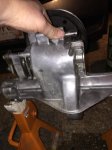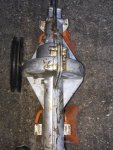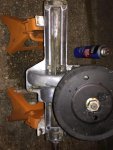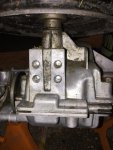Does that knocking sound also create a jerking type motion with the tires. I am wondering if the shift collar inside the tranny is worn or the shift fork is bent preventing proper engagement of the shift collar causing it to slip from notch to notch.
You are using an out of date browser. It may not display this or other websites correctly.
You should upgrade or use an alternative browser.
You should upgrade or use an alternative browser.
Another Slipping Pony
- Thread starter huskerfoos
- Start date
More options
Export threadbertsmobile1
Lawn Royalty
- Joined
- Nov 29, 2014
- Threads
- 64
- Messages
- 24,702
Does that knocking sound also create a jerking type motion with the tires. I am wondering if the shift collar inside the tranny is worn or the shift fork is bent preventing proper engagement of the shift collar causing it to slip from notch to notch.
Could be but that would make a grating more than a knocking wouldnt it ?
To me that vie of the sliding sheave looks very wrong.
The grey belt look too far out and the brown belt looks like it could be running on the spindle axis.
So I would have plugged for a spring fitted wrong or missing.
I have never been under a Pony , another model pretty thin on the ground down here.
Horses are the only ones I am familiar with but the varidrive system controls are nothing like each other.
Husker, does the vari drive pulley change when you change speeds ?
Could be but that would make a grating more than a knocking wouldnt it ?
To me that vie of the sliding sheave looks very wrong.
The grey belt look too far out and the brown belt looks like it could be running on the spindle axis.
So I would have plugged for a spring fitted wrong or missing.
I have never been under a Pony , another model pretty thin on the ground down here.
Horses are the only ones I am familiar with but the varidrive system controls are nothing like each other.
Husker, does the vari drive pulley change when you change speeds ?
When they slip it is more of a popping noise with the wheels creating a jerking motion when the collar slides in and out of the engaged gear. As far as the belts I can't tell if that one if not running square in the v notch since it looks fine on the edges, or the belt is disengaged in the picture. The vari drive pulley looks like it could have a wear groove at around the speed 4 setting.
I would also like to see a picture of the inside of the groove on the engine pulley.
huskerfoos
Member
- Joined
- Mar 3, 2018
- Threads
- 1
- Messages
- 26
Could be but that would make a grating more than a knocking wouldnt it ?
To me that vie of the sliding sheave looks very wrong.
The grey belt look too far out and the brown belt looks like it could be running on the spindle axis.
So I would have plugged for a spring fitted wrong or missing.
I have never been under a Pony , another model pretty thin on the ground down here.
Horses are the only ones I am familiar with but the varidrive system controls are nothing like each other.
Husker, does the vari drive pulley change when you change speeds ?
I'm still a couple hours from being home, but I will check.
Is it supposed to be relatively easy to change the speeds? Since I've had it up, looking at it, it seems a little hard to change thru the gears.
huskerfoos
Member
- Joined
- Mar 3, 2018
- Threads
- 1
- Messages
- 26
When they slip it is more of a popping noise with the wheels creating a jerking motion when the collar slides in and out of the engaged gear. As far as the belts I can't tell if that one if not running square in the v notch since it looks fine on the edges, or the belt is disengaged in the picture. The vari drive pulley looks like it could have a wear groove at around the speed 4 setting.
I would also like to see a picture of the inside of the groove on the engine pulley.
Sorry, I'm on mobile and it won't let me edit, it just deletes.
I will get a better pic of the pullies.
It does jerk, like it's engaging and disengaging. Not grinding like it's missing splines
EDIT
I tried again to stop the tires, initially it does jerk, but after listening, it starts grinding, I guess, sounding like a jack hammer.
The variable speed pulley does move as the gears are changed




Last edited:
huskerfoos
Member
- Joined
- Mar 3, 2018
- Threads
- 1
- Messages
- 26
I have tried to find other answers, but I am either missing it, or everything is correct. Is my next step, looking into the transaxle?
bertsmobile1
Lawn Royalty
- Joined
- Nov 29, 2014
- Threads
- 64
- Messages
- 24,702
if you do not get an answer in a couple of days, click on the [more] link on the right side then from the window that pops up select the :anyone: emojie.
This will bump your thread back into the "New posts " list so when regular posters go on line it will pop up.
I ( and I suspect many others ) do not get emails from the forum, I get around 200 or so a day so another 40 is not on.
Thus when people stop posting , the thread goes dead.
From where it was it looks like the suggestion of a jumping dog will be correct so it is time to pull out the tranny,
Usually a dog not properly engaging can be heard from 50' away with its distinctive machine gun ( jackhammer if you like ) rattle cause by the dogs grating over each other.
In the original post you did not mention this which is why those who repair mowers for a lining were concentrating on belts, pulleys & springs as these are fairly well quiet when they slip.
Just one of those things that happen when you are trying to diagnose from text on a screen
So it will be out with the tranny.
A fairly simple job as you already are an expert in changing the belts, after that it is just a matter of dissengaging the FNR control rod and the brake rod.
Double check the parts diagram as there are the 4 bolts on the axel itself ( 2 either side ) plus some stabilizers that are easy to overlook.
Give the tranny a really good clean as you do not want grit to get in there as then you have to change all of the grease and that is really messy.
On some the big pulley can be left in place on others it overhangs the case bolts so it has to come off.
DO not pull the shaft out or you will have to replace the seals and this goes for the axels as well.
there are some pry points to lever the two sides apart and then lift the top off.
Usually you only need to replace the actual sliding dog.
The shaft that moves it has some indents that run over a spring loaded ball bearing to index the sliding dog.
It has a habbit of vanishing into space when you take the dog out.
I used to clean all of the old dry grease out but now I just add some fresh 00 grease to free things up a bit.
A bit clumsy to explain but once apart it will be very obvious how it works.
Apart from the actual sliding dog, the collar that shifts it wears and so does the bushes at either end which allow the entire shaft to move left right.
They are not expensive and usually I replace the dog gear and both bushes,
Some have facilities for shims to go under the bushes to take up the free play.
This will bump your thread back into the "New posts " list so when regular posters go on line it will pop up.
I ( and I suspect many others ) do not get emails from the forum, I get around 200 or so a day so another 40 is not on.
Thus when people stop posting , the thread goes dead.
From where it was it looks like the suggestion of a jumping dog will be correct so it is time to pull out the tranny,
Usually a dog not properly engaging can be heard from 50' away with its distinctive machine gun ( jackhammer if you like ) rattle cause by the dogs grating over each other.
In the original post you did not mention this which is why those who repair mowers for a lining were concentrating on belts, pulleys & springs as these are fairly well quiet when they slip.
Just one of those things that happen when you are trying to diagnose from text on a screen
So it will be out with the tranny.
A fairly simple job as you already are an expert in changing the belts, after that it is just a matter of dissengaging the FNR control rod and the brake rod.
Double check the parts diagram as there are the 4 bolts on the axel itself ( 2 either side ) plus some stabilizers that are easy to overlook.
Give the tranny a really good clean as you do not want grit to get in there as then you have to change all of the grease and that is really messy.
On some the big pulley can be left in place on others it overhangs the case bolts so it has to come off.
DO not pull the shaft out or you will have to replace the seals and this goes for the axels as well.
there are some pry points to lever the two sides apart and then lift the top off.
Usually you only need to replace the actual sliding dog.
The shaft that moves it has some indents that run over a spring loaded ball bearing to index the sliding dog.
It has a habbit of vanishing into space when you take the dog out.
I used to clean all of the old dry grease out but now I just add some fresh 00 grease to free things up a bit.
A bit clumsy to explain but once apart it will be very obvious how it works.
Apart from the actual sliding dog, the collar that shifts it wears and so does the bushes at either end which allow the entire shaft to move left right.
They are not expensive and usually I replace the dog gear and both bushes,
Some have facilities for shims to go under the bushes to take up the free play.
huskerfoos
Member
- Joined
- Mar 3, 2018
- Threads
- 1
- Messages
- 26
if you do not get an answer in a couple of days, click on the [more] link on the right side then from the window that pops up select the :anyone: emojie.
This will bump your thread back into the "New posts " list so when regular posters go on line it will pop up.
I ( and I suspect many others ) do not get emails from the forum, I get around 200 or so a day so another 40 is not on.
Thus when people stop posting , the thread goes dead.
From where it was it looks like the suggestion of a jumping dog will be correct so it is time to pull out the tranny,
Usually a dog not properly engaging can be heard from 50' away with its distinctive machine gun ( jackhammer if you like ) rattle cause by the dogs grating over each other.
In the original post you did not mention this which is why those who repair mowers for a lining were concentrating on belts, pulleys & springs as these are fairly well quiet when they slip.
Just one of those things that happen when you are trying to diagnose from text on a screen
So it will be out with the tranny.
A fairly simple job as you already are an expert in changing the belts, after that it is just a matter of dissengaging the FNR control rod and the brake rod.
Double check the parts diagram as there are the 4 bolts on the axel itself ( 2 either side ) plus some stabilizers that are easy to overlook.
Give the tranny a really good clean as you do not want grit to get in there as then you have to change all of the grease and that is really messy.
On some the big pulley can be left in place on others it overhangs the case bolts so it has to come off.
DO not pull the shaft out or you will have to replace the seals and this goes for the axels as well.
there are some pry points to lever the two sides apart and then lift the top off.
Usually you only need to replace the actual sliding dog.
The shaft that moves it has some indents that run over a spring loaded ball bearing to index the sliding dog.
It has a habbit of vanishing into space when you take the dog out.
I used to clean all of the old dry grease out but now I just add some fresh 00 grease to free things up a bit.
A bit clumsy to explain but once apart it will be very obvious how it works.
Apart from the actual sliding dog, the collar that shifts it wears and so does the bushes at either end which allow the entire shaft to move left right.
They are not expensive and usually I replace the dog gear and both bushes,
Some have facilities for shims to go under the bushes to take up the free play.
OK, I finally had a good weekend to start looking at this thing. I will post some pics at the bottom, but they are just of the trans after I took it out, and some are before I cleaned it up. Pressure washer, then a scrub brush and some dawn, then n the tight areas some brake cleaner.
My trans pulley sits over 5 bolts, but unless they are extremely long, I should be able to get them out. You mention the "dog" not engaging. Are you referring to the shaft that slides over the ball bearing, or the peace that engages the fwd/rev gears? I did find a youtube video and this is the problem they had, but he couldn't engage drive at all according to him.
I have an early movie date with the wife and kids tomorrow, but will be home around lunch to crack this thing open.
Thanks for your assessment on my situation, as to all the others that that had replied previously.




bertsmobile1
Lawn Royalty
- Joined
- Nov 29, 2014
- Threads
- 64
- Messages
- 24,702
In photo 5 there is still some grass under the pulley , it should just blow off.
The two sides join together along the split line you can see, it s flat so that is as long as the bolts will be.
You will need to remove the brake by undoing the two small nuts on the outer edges, leave the big one alone.
Take a photo of where the lever sits and the springs anchor as it is not apparent when you go to refit it.
Inside the caliper are 2 very short rods, a steel shim brake plate the disc then another brake ( Puck ) another steel shim.
These bits tend to vanish into an alternative dimension when you dissassemble them so pop a carton underneath the brake to catch them .
The gap in the cases at the join line in photo 5 is a pry point to split the 2 halves, there are a couple more of them, they all look the same.
Gentle is the word, the joint face is usually held together with silicon but splits well if you have some long pry bars ( screwdrivers etc ).
Inside will be a revolting mess of grease so it is glove time.
The type of clutching mechanism where two parts with slots lock into each other is called a DOG CLUTCH don't know why ,
One side is fixed and the other slides.
The sliding part is called the DOG or Sliding Dog
By now you should have the Peerless ( Tecumseh) manual and read the relevent bits.
Some need to come apart upside down and others right side up.
You will not do any damage but loose parts can fall out causing confusion.
The two sides join together along the split line you can see, it s flat so that is as long as the bolts will be.
You will need to remove the brake by undoing the two small nuts on the outer edges, leave the big one alone.
Take a photo of where the lever sits and the springs anchor as it is not apparent when you go to refit it.
Inside the caliper are 2 very short rods, a steel shim brake plate the disc then another brake ( Puck ) another steel shim.
These bits tend to vanish into an alternative dimension when you dissassemble them so pop a carton underneath the brake to catch them .
The gap in the cases at the join line in photo 5 is a pry point to split the 2 halves, there are a couple more of them, they all look the same.
Gentle is the word, the joint face is usually held together with silicon but splits well if you have some long pry bars ( screwdrivers etc ).
Inside will be a revolting mess of grease so it is glove time.
The type of clutching mechanism where two parts with slots lock into each other is called a DOG CLUTCH don't know why ,
One side is fixed and the other slides.
The sliding part is called the DOG or Sliding Dog
By now you should have the Peerless ( Tecumseh) manual and read the relevent bits.
Some need to come apart upside down and others right side up.
You will not do any damage but loose parts can fall out causing confusion.
huskerfoos
Member
- Joined
- Mar 3, 2018
- Threads
- 1
- Messages
- 26
I have the MTD professional shop manual that was referenced earlier in the thread. It does not mention whether it needs to be taken apart upside down or anything.
I also was not able to remove the pulley, so, I'm hoping that won't be a problem in checking things during the process.
I also was not able to remove the pulley, so, I'm hoping that won't be a problem in checking things during the process.
